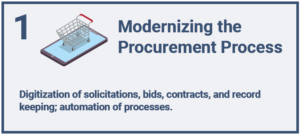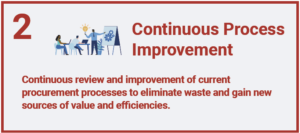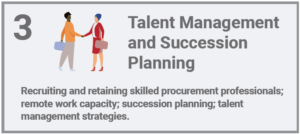Top Ten Priorities
While we all anxiously await the holidays and the arrival of 2024, NASPO members have given us a preview of what their offices will be working on in the coming year.
At 2023’s NASPO Annual Conference, we surveyed the CPOs from each state to learn about the challenges and goals they are focused on for the new year. The results have been collected and published as NASPO’s 2024 Top Ten Priorities for State Procurement Offices. Pulse is here to give you a peek at what we learned.
NASPO’s annual Top Ten Priorities for State Procurement guides the organization, informing the issues and topics included in our research and educational content, conferences, and trainings. According to our primary members, the top priorities for 2024 are:
- Modernizing the Procurement Process
- Continuous Process Improvement
- Talent Management and Succession Planning
- Customer Service to Agency Stake Holders
- eProcurement
- Central Procurement Office as a Strategic Leader
- Analytics for Data-Driven Decision Making
- Effective Contract Administration
- Training and Certification
- Innovative Solution-based Solicitation Methods
Positive Changes
This year’s top priorities suggest state procurement is focused on making positive changes for present and future performance.

The number one priority for 2024 focuses on incorporating technology into the procurement process to increase efficiency and access to information. Software solutions that facilitate all parts of the procurement process and make paper-based procedures obsolete have been a staple of modern private-sector procurement for years. Procurement has evolved, and states are focusing on adopting new business methods.
For more on modernizing government, check out Implementing eGovernment: 3 Lessons from Estonia, and listen to Threats Facing Digital Government on the Pulse Podcast.

How can we do better? This eternal question is at the heart of our second priority for 2024. Procurement offices are looking to their processes for opportunities to add value or efficiency. Challenges such as budgetary constraints, increases in purchase requisitions, compliance consistency issues, and reducing mistakes can be mitigated by innovating and improving procurement processes following a rigorous and thoughtful review.
To get started on process improvement, read Considering Outcomes (Not Just Outputs) Through Your KPIs and Design Thinking: 5 Phases to Better Serve the Public. For a deep dive into one approach for gaining efficiency in the procurement process, check out Modular Procurement: A Primer.

Succession planning requires focusing on the organization’s future and anticipating future needs. As experienced leaders and team members retire or transition out, procurement officers are left with the question, “Who’s next?” Successful succession planning and talent management demands:
- Identifying the strengths and talents of your team members
- Identifying potential future positions and paths for their careers
- Providing them with the professional development opportunities and training necessary for them to fill those roles
For more on talent management, check out Talent Management in a Changing World, and for tips on succession planning, read Succession Planning: Don’t Just Plan for Your Future here on Pulse.
A closer inspection of other priorities on the list further supports public procurement’s focus on implementing change, both for the present and in preparation for the future. Making changes for the present suggests getting the most out of current resources, tools, and processes. In addition to Continuous Process Improvement, as discussed above, these other identified priorities involve beneficial changes:
#5. eProcurement – increasing statewide adoption and use of electronic procurement solutions for better data, reporting, and outcomes
#8. Effective Contract Administration – identifying best practices and standardizing procedures to improve contract monitoring and supplier performance
#9. Training and Certification – developing the skills and capacity of your team to improve performance and elevate the procurement profession. Implementing change in preparation for the future involves transitioning to the next generation of public procurement processes and personnel. Beyond our previous discussion of Modernizing the Procurement Process and Talent Management and Succession Planning, these identified priorities involve embracing an evolving public procurement environment.
#7. Analytics for Data-Driven Decision Making – Using data analytics and tools to forecast needs and guide procurement decisions for optimal outcomes and value
#10. Innovative Solution-Based Solicitation Methods – meeting customer needs and providing effective solutions through outcome-focused best-value solicitations and strategies
If you would like to see how procurement priorities have evolved, check out past Top Ten Priorities lists in the NASPO Content Library. While you are there, browse through all the procurement topics listed to find more informational resources to address your office’s priorities this year. Watch for upcoming publications, events, and educational opportunities on NASPO.org as we continue to produce resources based on the Top Ten throughout 2024.
